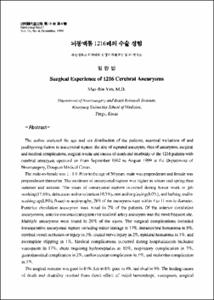뇌동맥류 1216례의 수술 경험
- Keimyung Author(s)
- Yim, Man Bin
- Department
- Dept. of Neurosurgery (신경외과학)
- Journal Title
- Keimyung Medical Journal
- Issued Date
- 1999
- Volume
- 18
- Issue
- 4
- Keyword
- Intracranial aneurysm; Overview; Outcome
- Abstract
- The author analysed the age and sex distribution of the patients, seasonal variations of and predisposing factors to aneurysmal rupture, the size of ruptured aneurysm, sites of aneurysms, surgical and medical complications, surgical results and causes of death and morbidity of the 1216patients with cerebral aneurysm operated on from September 1982 to August 1999 at the Department of Neurosurgery, Dongsan Medical Center.
The male-to-female was 1 : 1.9. Prior to the age of 50 years, male was preponderant and female was preponderant thereafter. The incidence of aneurysmal rupture was higher in winter and spring than summer and autumn. The onset of aneurysmal rupture occurred during house work or job working(17.5%), defecation and/or urination(10.3%), rest and/or playing(9.0%), and bathing and/or washing up(8.9%). Based on angiography, 79% of the aneurysms were within 4 to 11 mm in diameter. Posterior circulation aneurysms were noted in 7% of the patients. Of the anterior circulation aneurysms, anterior communicating/anterior cerebral artery aneurysm was the most frequent site. Multiple aneurysms were found in 20% of the cases. The surgical complications included intraoperative aneurysmal rupture including minor leakage in 17%, intracerebral hematoma in 5%, cerebral vessel occlusion or injury in 3%, cranial nerve injury in 2%, epidural hematoma in 1%, and incomplete clipping in 1%. Medical complications occurred during hospitalization included vasospasm in 17%, shunt requiring hydrocephalus in 10%, respiratory complication in 7%, gastrointestinal complication in 2%, cardiovascular complication in 1%, and endocrine complication in 1%.
The surgical outcome was good in 81%, fair in 6%, poor in 4%, and dead in 9%. The leading causes of death and disability resulted from direct effect of initial hemorrhage, vasospasm, surgical complications, rebleeding and medical complications.
There was no definite difference between our cases and those of other literatures in age and sex distribution, the size of ruptured aneurysms and sites of aneurysms. Regarding the surgical results, there is some room for improvement. The opportunities for improvement will be related to decreasing the rate of surgical and medical complications and proper management of ischemia related to the vasospasm.
- Alternative Title
- Surgical Experience
of 1216 Cerebral Aneurysms
- Keimyung Author(s)(Kor)
- 임만빈
- Publisher
- Keimyung University School of Medicine
- Citation
- 임만빈. (1999). 뇌동맥류 1216례의 수술 경험. Keimyung Medical Journal, 18(4), 451–462.
- Type
- Article
- Appears in Collections:
- 2. Keimyung Medical Journal (계명의대 학술지) > 1999
1. School of Medicine (의과대학) > Dept. of Neurosurgery (신경외과학)
- 파일 목록
-
-
Download
 18-451.pdf
기타 데이터 / 631.72 kB / Adobe PDF
18-451.pdf
기타 데이터 / 631.72 kB / Adobe PDF
-
Items in Repository are protected by copyright, with all rights reserved, unless otherwise indicated.